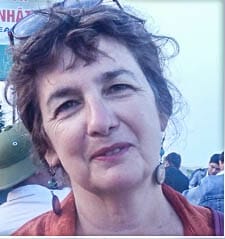As the curtain rises we see a dancer positioning an oversized glaring white klieg light capable of illuminating a night time Las Vegas casino exterior. The blaring sterile light focuses our eyes on a white clad dancer backstage on the ground. It feels like a crime scene. She is akin to a moving cadaver. Her ankles together, her legs become a diamond shape that opens and closes, then transitioning into other shapes and repeated gestures. Meanwhile, a figure in the shadows clings to the stage right wall, similarly exploring the terrain where geometry and gesture meet. Dancers move in and out of the shadows cast by a screen blocking half the stage. Their moves are quick and often quirky. They don’t exit as much as evaporate.
We feel like we have been catapulted into a film noir murder scene. It is not the stereotypic detective, victim and suspects, however. This crime scene is animated by geometries that morph into an ever changing electronic music soundscape. Our ears are taken over by the aharmonious backdrop of an automated assembly line —sometimes making almost pneumatic pouts machine style, and sometimes settling into hum fast swallowing the air. The music is ever changing and steering clear of anything with a coda feel.
Emerging from the shadows, eleven dancers of the Ballet de l’Opéra National du Rhin are bringing choreographer William Forsythe’s work Enemy in the Figure to life. A thick rope sometimes lying flat and sometimes thrown into snaking ripples joins the blaring light, screen, score and dancers as equal partners to shape our sense of a narrative being told to us in a new and foreign tongue.
Costumes are stark— white leotards, bare chest or black— except for the few of layered tutus that spring into action when the dancers pirouette or make other fast moves at times reminding of a kitchen scrub brush.
Dream States from Choreographers CHILDS, BOUCHÉ, FORSYTHE
Forsythe’s Enemy in the Figure was the post intermission finale in this three-part program of the Ballet de l’Opéra national du Rhin.
Lucinda Childs’ Songs from Before accompanied by Max Richter music set the stage, in all senses, for the feeling of dreams that permeated the evening’s performances.
Lines of dancers cross the stage with minimalist repetitive moves that mirror the repetitions of Richter’s score. At first it is a simple step, step, lift on toe, step, step, lift on toe, step, step, lift on toe. Then, as later in Forsythe’s work, the set design takes over to become in some ways the most significant actor on the stage. Screens move into different positions to sometimes cast plaid shadows before them, crisscrossing or zooming stripes, and other shadow patterns. They wax and wane in mirror quality with the light, such that the ensemble numbers seem to multiply at times. We double take at dancers who are really crossing the stage to dance from behind the screen, thinking for demi-seconds that they are also mirrored duet partners. A meditative voice overlays the dance with English spoken poetry of writer Huruki Murakimi. The choreography has taken us on a visualization of deep breathing exercises and solitude savored more than the food at a Buddhist retreat.
The most literal of narratives in the program came from the dance troupe’s director, Bruno Bouché, in his interpretation of the Bible’s Book of Genesis story of Jacob wrestling the Angel. In this evening’s performance, the Angel is dancer Cauê Frias, whose tall frame helps him lord over muscled but seemingly more human scale dancer Marin Delavaud. For this reviewer however, these two dancers seemed mostly to underline the cut above grace among the male dancers as a whole in the Ballet de l’Opéra national du Rhin troupe.
Théâtre de la Ville Sarah Bernhardt Space is Tailor-Made for Choreographic Excellence
For an American in Paris, the grand hall where the Ballet de l’Opéra national du Rhin performs is itself an attraction. You are mainly with Parisians, not the tourist throng. Plastic seat boosters accommodate well-behaved children. There are even companion pets among us. The seats are super comfortable and raked for perfect sightlines throughout the large Sarah Bernhardt Space. A fellow American sitting beside us who hails from Denver felt that the audience was younger than what she is accustomed to back home. For this dance reviewer, it seemed more difficult to spot the typical concentration of dancers in the audience that often predominate in cities like Chicago or New York with active dance communities.
There are eight more productions in the Théâtre de la Ville’s 2023/2024 dance season that will conclude a week+ prior to the Olympics. These are a top pick for your time.
HIGHLY RECOMMENDED
For more information visit the dance pages of the Théâtre de la Ville website.
Photos: Courtesy of Théâtre de la Ville, photographer Agathe Poupeney, unless otherwise indicated
Find more Picture This Post dance reviews in the latest roundup — CHOREOGRAPHERS WE LOVE. Also, watch a short preview video here —

About the Author: Amy Munice
Amy Munice is Editor-in-Chief and Co-Publisher of Picture This Post. She covers books, dance, film, theater, music, museums and travel. Prior to founding Picture This Post, Amy was a freelance writer and global PR specialist for decades—writing and ghostwriting thousands of articles and promotional communications on a wide range of technical and not-so-technical topics.


















